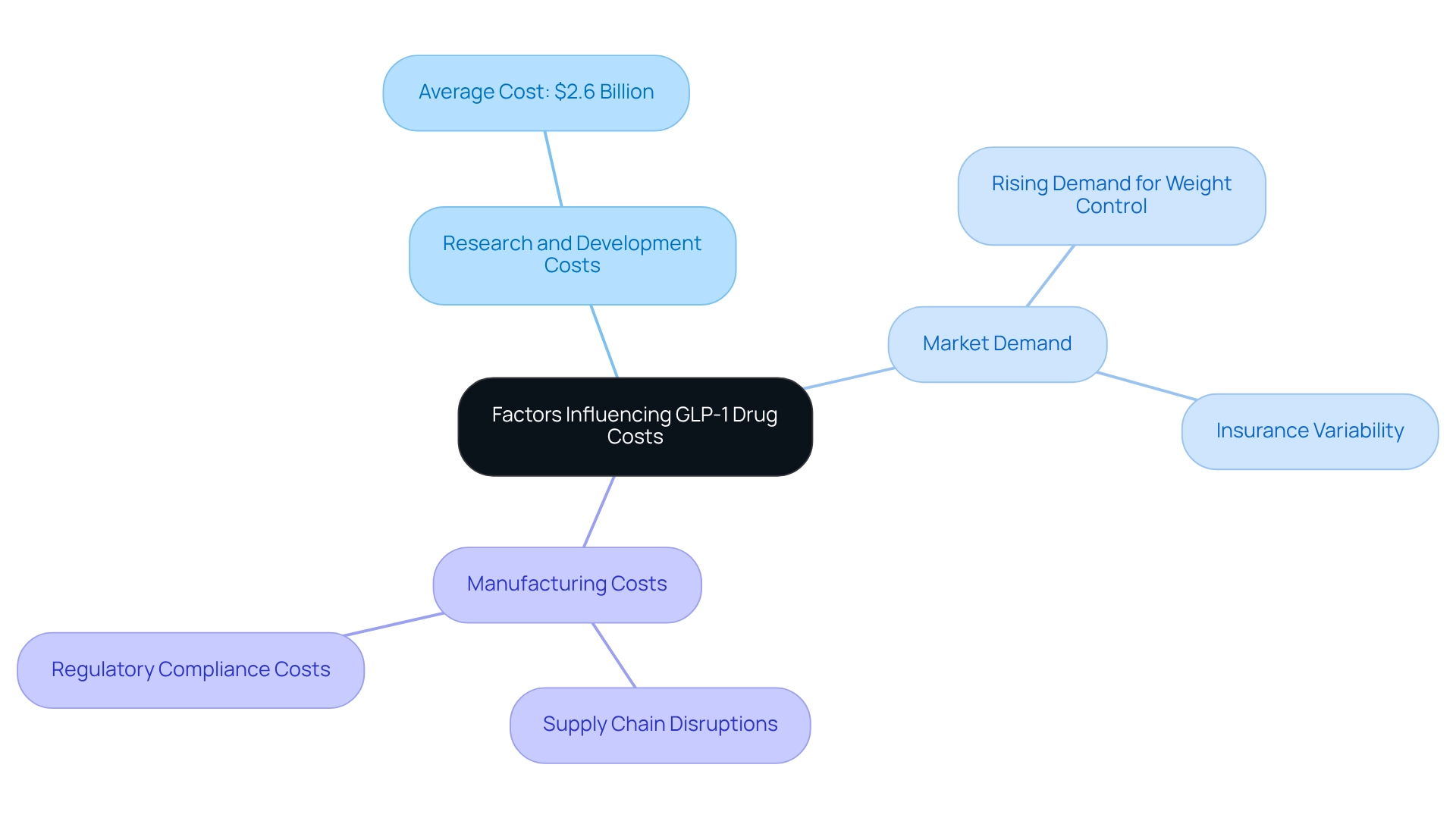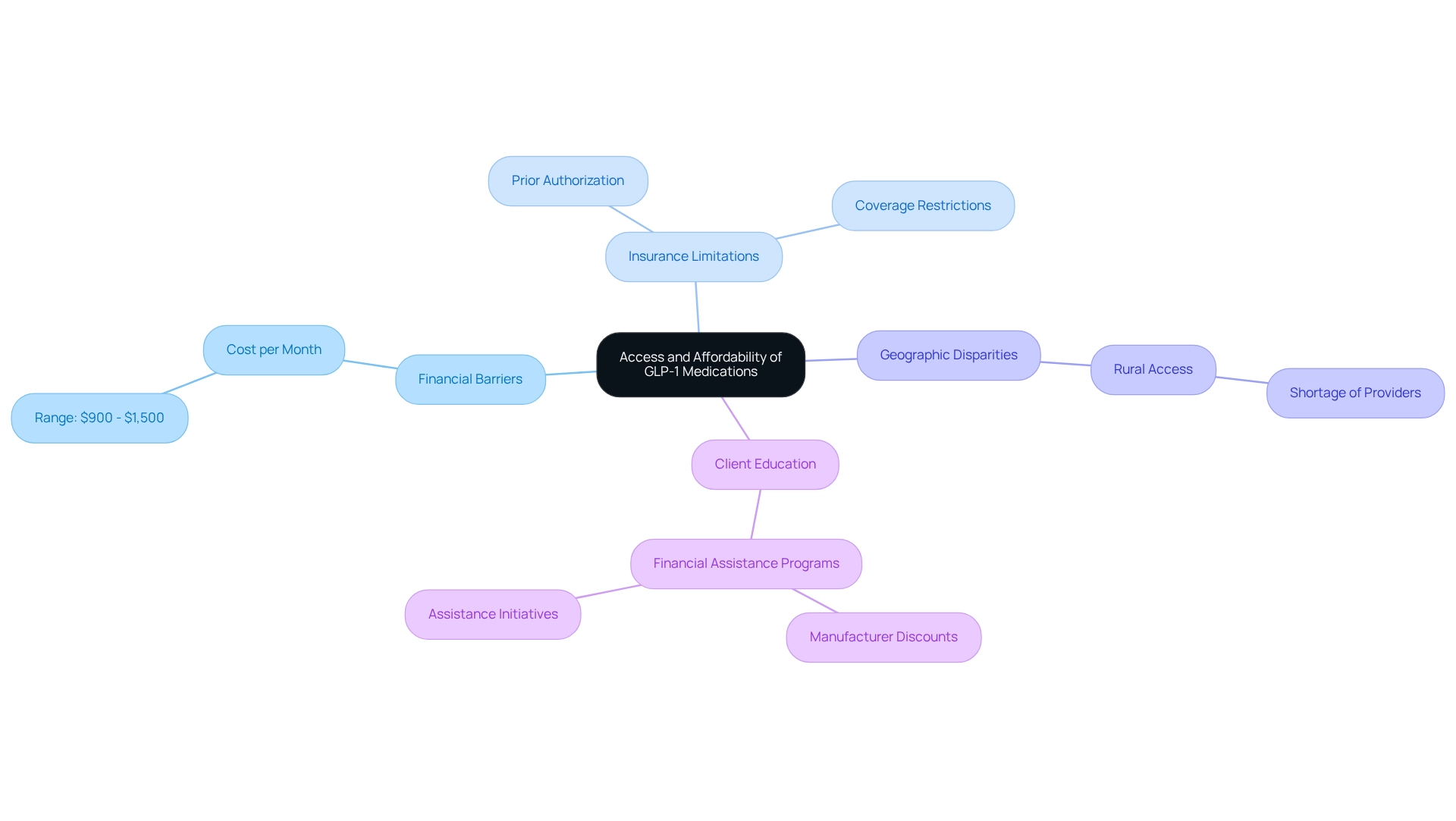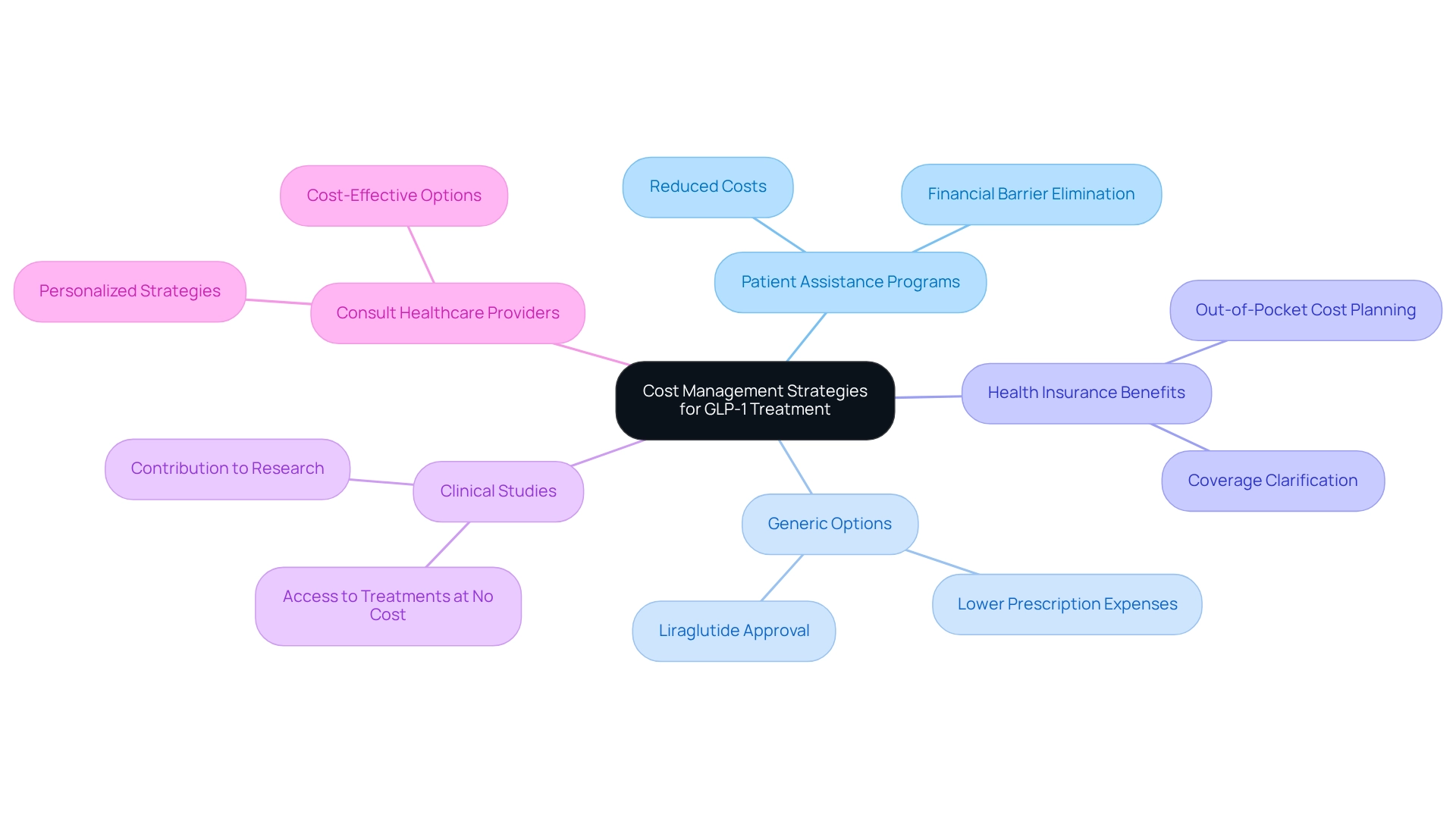Overview
Understanding the monthly costs associated with GLP-1 medications can feel overwhelming, but we’re here to help you navigate this journey. These costs typically range from $900 to $1,500 each month, influenced by factors such as research and development expenses, market demand, and manufacturing costs. It’s important to recognize that you’re not alone in this; many individuals share similar concerns about affordability.
To improve access, consider exploring patient assistance programs and insurance benefits. These resources can significantly alleviate the financial burden and make a positive difference in your experience. Remember, together, we can achieve your goals, and there are options available to help you manage these costs effectively.
As you reflect on your weight loss journey, know that support is available. By understanding these financial aspects, you can take proactive steps towards better health without feeling overwhelmed. We encourage you to reach out for assistance and explore the various avenues that can help make GLP-1 medications more affordable.
Introduction
In the realm of modern medicine, GLP-1 drugs have emerged as a groundbreaking solution for managing Type 2 diabetes and obesity. These innovative medications, such as Ozempic and Wegovy, mimic the natural hormone GLP-1, enhancing satiety and regulating blood sugar levels. As the prevalence of obesity and diabetes continues to rise, it’s essential to understand the dual benefits of these treatments. However, we recognize that the journey to access these medications can be challenging, often marked by high costs and insurance limitations.
This article delves into the multifaceted landscape of GLP-1 drugs, exploring their effectiveness and the factors influencing their pricing. Together, we can navigate these barriers to access and affordability, ensuring that you have the information and support you need on your weight loss journey. Remember, we’re here for you, and with the right strategies, you can overcome these obstacles.
Define GLP-1 Drugs and Their Uses
Glucagon-Like Peptide-1 medications represent a significant advancement in managing Type 2 diabetes and obesity, and we understand how challenging these conditions can be. Medications like Ozempic, Wegovy, and Rybelsus work by mimicking the hormone that helps regulate blood sugar levels and appetite. By enhancing feelings of fullness and reducing food intake, these treatments not only improve glycemic control but also support weight loss, making them a dual-purpose option for those navigating these chronic challenges.
Recent research underscores the effectiveness of these treatments, revealing that many individuals using them can achieve substantial weight loss, often shedding between 15-20% of their body weight within just six months. This information is especially important given the increasing rates of obesity and Type 2 diabetes in the United States, affecting millions and leading to various health complications. At Minimal, we prioritize a patient-centered approach to wellness, combining weight loss prescriptions with personalized fitness and nutrition guidance to foster lasting health improvements.
Current guidelines advocate for the use of receptor agonists in individuals with diabetes, particularly for those at risk of cardiovascular issues. This recommendation is backed by clinical trials that demonstrate the drugs’ effectiveness in lowering cardiovascular risks among individuals with obesity and atherosclerotic vascular disease. However, it’s essential to acknowledge that while these medications can significantly improve health outcomes, they do not address all the underlying factors contributing to obesity. For instance, an incidence of acute pancreatitis was observed at 0.3% in the placebo group, highlighting potential risks associated with these medications.
Healthcare professionals emphasize the importance of integrating pharmacotherapy with lifestyle changes for effective obesity treatment. It’s worth noting that the trials primarily included individuals with preexisting cardiovascular disease, which may limit the applicability of the results to a broader audience. This comprehensive approach not only maximizes the benefits of these medications but also encourages lasting health improvements for patients. Understanding how these drugs function in managing these conditions is vital for evaluating their cost-effectiveness, including the glp-1 cost per month, and accessibility within healthcare systems. Together, we can achieve your health goals and navigate this journey with support and understanding.
Analyze Factors Influencing GLP-1 Drug Costs
Understanding the glp-1 cost per month associated with GLP-1 medications can feel overwhelming, but it’s essential to recognize the key factors that contribute to these costs:
- Research and Development Costs: The journey of bringing new drugs to market is paved with substantial expenses. On average, the research and development for new diabetes treatments can exceed $2.6 billion. This highlights not just the financial investment but also the time and resources dedicated to ensuring effective solutions for individuals seeking help.
- Market Demand: As more people seek effective weight control options, the demand for these medications has surged. This growing popularity often leads to higher prices, as healthcare professionals aim to provide the latest therapies, which can affect the glp-1 cost per month. With expectations for this demand to rise even further in 2025, it’s crucial to understand how market dynamics influence the glp-1 cost per month, as the variability in insurance plans can significantly affect patients’ out-of-pocket expenses. Many policies have restrictive coverage, which can create barriers for those without adequate insurance. This inconsistency can make accessing these valuable treatments more challenging, particularly when considering the glp-1 cost per month.
- Manufacturing Costs: Producing GLP-1 medications involves intricate processes, and factors like supply chain disruptions can drive prices up. These challenges make it difficult for manufacturers to maintain stable pricing, adding to the overall cost burden, which can include the glp-1 cost per month due to compliance with strict regulatory standards that adds another layer of expense. While rigorous testing and approval processes are necessary for ensuring safety and efficacy, they also increase the financial strain on pharmaceutical companies, which is reflected in the glp-1 cost per month, impacting their overall profitability that averages about 13.8%, compared to 7.7% for nonpharmaceutical firms. This financial landscape plays a significant role in shaping pricing strategies for medications, including the glp-1 cost per month. Many question the responsibilities of pharmaceutical companies in providing affordable treatments for those in need, particularly in light of the glp-1 cost per month.
Future research directions highlight the pressing need to explore how increased pharmaceutical spending impacts individuals, payors, and the healthcare system, as well as the effectiveness of newer drugs. Recognizing these factors is crucial as we navigate the complexities of treatment pricing, especially with the anticipated changes in 2025. As Dr. Chance Miller emphasizes, clients truly value the personalized attention from a dedicated care team. Together, we can work towards integrating effective treatments with comprehensive care, ensuring that everyone feels supported on their journey.
Evaluate Access and Affordability of GLP-1 Medications
Access to GLP-1 medications can be a challenging journey for many individuals, often hindered by several critical factors that deserve our attention and understanding.
The GLP-1 cost per month for medications can range from $900 to $1,500, making them unaffordable for many patients without insurance coverage. This financial barrier significantly limits access to these essential treatments, leaving individuals feeling overwhelmed and concerned about their health.
- Insurance Limitations: Many health plans impose stringent criteria for coverage, often requiring prior authorization or restricting prescriptions to specific medical conditions. This can create extra obstacles for individuals seeking these treatments. As Joshua P. Cohen notes, “The lack of cost-effectiveness can limit insurance coverage and prevent equitable access.” How can we help bridge these gaps?
- Geographic Disparities: Access to GLP-1 medications can vary widely based on geographic location. Rural areas, especially, frequently face shortages of healthcare providers qualified to prescribe these treatments, further complicating access for individuals in those regions. It’s important to acknowledge these disparities and advocate for better solutions.
- Client Education: A lack of awareness regarding available financial assistance programs can hinder individuals from obtaining necessary treatments. Programs like manufacturer discounts and assistance initiatives can help reduce some of the financial burdens linked to these drugs. Together, we can raise awareness and ensure that everyone knows their options.
The challenges of accessing GLP-1 therapies are compounded by the fact that approximately 20% of members disenroll from health insurance plans each year, which complicates understanding the GLP-1 cost per month and the cost-effectiveness of these treatments. This issue is further illustrated in the case study titled ‘Impact of Member Churn on Cost-Effectiveness,’ which highlights how insurers may struggle to recognize long-term benefits from high-cost treatments when individual adherence is uncertain. Moreover, specialist views stress that the absence of cost-efficiency can restrict insurance coverage and fair access to these treatments. This emphasizes the necessity for systemic alterations to enhance affordability and access for everyone.
Real-world instances of cost difficulties encountered by individuals seeking these treatments further highlight the urgent requirement for solutions in this domain. Remember, we’re here for you, and together, we can achieve your goals for better health.
Implement Strategies for Cost Management in GLP-1 Treatment
Managing the costs associated with GLP-1 treatments can feel overwhelming, but there are several effective strategies that can help you navigate this journey with confidence:
- Utilize Patient Assistance Programs: Many pharmaceutical companies offer patient assistance programs designed to provide medications at reduced costs, or even for free, to those who qualify. These programs aim to eliminate financial barriers, ensuring that you have access to the essential treatments you need. It’s heartening to know that statistics show these programs can significantly alleviate financial strain for many individuals.
- Explore Generic Options: With the recent approval of liraglutide as a generic medication, you have the opportunity to significantly lower your prescription expenses. This advancement is a promising shift in the realm of weight-loss drugs, making them more accessible and affordable for those managing weight and related health challenges.
- Utilize Health Insurance Benefits: Understanding your insurance plan’s coverage for weight loss medications is crucial. By reaching out to your insurer, you can clarify coverage details and potential out-of-pocket costs, allowing for more effective financial planning. With the anticipated growth of GLP-1s by at least 20% annually, knowing your benefits is more important than ever.
- Engage in Clinical Studies: You might find that participating in clinical trials can provide access to certain treatments at no cost. This not only allows you to receive necessary care but also contributes to valuable research that can benefit others in the future.
- Consult Healthcare Providers: Regular conversations with your healthcare providers about medication management can lead to personalized strategies that align with your financial situation and health aspirations. As Dr. Chance Miller emphasizes, “Clients appreciate the personalized attention from a dedicated care team, which includes physicians who emphasize transformative care.” Your providers can offer insights into cost-effective options and adjustments tailored to your unique circumstances.
By implementing these strategies, you can navigate the financial landscape of GLP-1 treatments more effectively, taking into account the GLP-1 cost per month to ensure you receive the necessary care without undue financial burden. Remember, together, we can achieve your goals.
Conclusion
The exploration of GLP-1 drugs reveals their vital role in managing Type 2 diabetes and obesity, showcasing their dual benefits in enhancing satiety and regulating blood sugar levels. Medications like Ozempic and Wegovy have shown remarkable effectiveness, helping many patients achieve significant weight loss. Yet, the path to accessing these treatments can feel overwhelming, primarily due to high costs and insurance limitations. Understanding the interplay of research and development expenses, market demand, and regulatory factors is essential for grasping the complexities surrounding the pricing of these medications.
Moreover, access to GLP-1 treatments is further complicated by geographic disparities and a lack of patient education regarding available financial assistance programs. The financial burden of these medications can be daunting, especially for those without insurance coverage. This highlights the urgent need for systemic changes to enhance affordability, ensuring that everyone can benefit from these innovative treatments.
Implementing effective cost management strategies is crucial for patients navigating this landscape. Consider:
- Utilizing patient assistance programs
- Exploring generic options
- Leveraging health insurance benefits
- Consulting healthcare providers
These proactive steps can significantly alleviate financial strains, ensuring that you have access to the necessary care while managing costs effectively. Together, we can overcome these barriers, promoting better health outcomes and improving the quality of life for those affected by obesity and diabetes.
Remember, you’re not alone in this journey. By taking action and seeking support, you can pave the way for a healthier future. Let’s work together to achieve your goals and embrace the possibilities ahead.
Frequently Asked Questions
What are Glucagon-Like Peptide-1 (GLP-1) medications used for?
GLP-1 medications are used to manage Type 2 diabetes and obesity by mimicking a hormone that regulates blood sugar levels and appetite.
How do GLP-1 medications work?
These medications enhance feelings of fullness and reduce food intake, which improves glycemic control and supports weight loss.
What are some examples of GLP-1 medications?
Examples of GLP-1 medications include Ozempic, Wegovy, and Rybelsus.
What kind of weight loss can individuals expect when using GLP-1 medications?
Many individuals using GLP-1 medications can achieve substantial weight loss, often losing between 15-20% of their body weight within six months.
Why is the use of GLP-1 medications important in the context of obesity and Type 2 diabetes in the United States?
With increasing rates of obesity and Type 2 diabetes affecting millions, GLP-1 medications provide an effective treatment option that addresses both conditions and helps prevent health complications.
Are there any cardiovascular benefits associated with GLP-1 medications?
Yes, clinical trials have shown that GLP-1 medications can lower cardiovascular risks among individuals with obesity and atherosclerotic vascular disease.
What risks are associated with GLP-1 medications?
One potential risk is the incidence of acute pancreatitis, which was observed at a rate of 0.3% in the placebo group during trials.
How should GLP-1 medications be integrated into treatment for obesity?
Healthcare professionals emphasize that pharmacotherapy should be combined with lifestyle changes for effective obesity treatment.
Who were the participants in the clinical trials for GLP-1 medications?
The trials primarily included individuals with preexisting cardiovascular disease, which may limit the applicability of the results to a broader audience.
How can individuals evaluate the cost-effectiveness of GLP-1 medications?
Understanding how these drugs function in managing diabetes and obesity is vital for evaluating their cost-effectiveness and accessibility within healthcare systems.




















